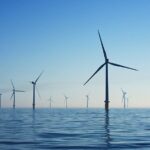Dominion Energy’s decision to build a gigantic windfarm and have net zero emissions by 2045 is a political ploy rather than a well-developed business decision. Why do I say that? First, Dominion buys bi-partisan political support in the General Assembly, as if it was needed. Second, it now gets broad support from the environmental community. And, if it flops, as it is likely to do, rate payers will be left holding the bail-out bag.
Dominion plans to site over 200 windmills 27 miles off of the coast of Virginia. The area occupied will be about 176 square miles, which is three times larger than Richmond and about the size of Clarke County. The current cost estimate for this project is $7.8 billion, but that will certainly increase.
By committing to a project of this size, Dominion is freezing innovation and putting its transmission grid at risk. The cold spell that is gripping the U.S. reveals a major vulnerability of wind and solar as well as the vulnerability of the grid.
Wind mills In Texas are frozen, and in Europe the lack of wind has idled Germany’s wind power. As Jim pointed out in an earlier post, “In the midst of a bitter cold snap expected to last several days, ice storms knocked out nearly half the state’s wind-power generating supply. The spot price of electricity has surged to $9,000 per megawatt hour, compared to $100 per megawatt hour during periods of high summer demand.”
While the Texas power problem is more complex than just wind and solar, it should be a cautionary tale about trying to electrify the Commonwealth with reliance on renewables. There is value in diversity of energy sources and a reliable grid. As The Washington Post observed, “Modernizing the electrical grid to make it more resilient, more efficient and more secure is the worst kind of challenge: complex, expensive and easy to ignore.” Given the widespread blackouts over the past several days, Dominion has ignored it while spending on placating the Greens.
Over the next two decades there will be advances in technology that could make the windfarm a white elephant. For example, a number of companies here and in Europe are pursing Carbon Capture and Storage (CCS) projects. The United Nations Intergovernmental Panel on Climate Change and the International Energy Agency agree that CCS is one of the most important low-carbon technologies required to achieve societal climate goals at the lowest cost. CCS is also one of the only technologies that could enable some industry sectors to decarbonize, including the refining, chemicals, cement and steel sectors. ExxonMobil has recently announced the formation of a business unit to commercialize its carbon-capture and low=carbon technology and has projects and partnerships in a number of countries. If this technology becomes commercially viable in next two decades the value of wind power will be diminished
While many have turned their backs on the nuclear option because of cost and safety concerns, the nuclear industry is forging ahead in work to address those concerns. Small Modular Reactors hold out a great deal of promise because being modular, many components can be mass produced, hence lowering the cost. They can substitute for coal and gas fired power and being combined in increments is a way to boost capacity as needed. GE is developing a reactor that can be sited below ground in water, increasing its safety. The focus today seems to be about making reactors simpler and more reliable.
The attack on nuclear by some environmentalists and the media is really a case of fake news. The effects of well publicized accidents at Three Mile Island and Fukushima produced no deaths or cases of radiation poisoning. While Chernobyl was the worst nuclear disaster ever to take place, it is not relevant to the U.S. The reactor design was unique and the accident was caused by negligence — there were no fail-safes to prevent radiation from escaping, personnel were poorly trained, and no safety measures were in place to protect against the mistakes that were made. Chernobyl was a disaster waiting to happen.
Dominion should consider all viable options and not prematurely lock in the wind farm. Since it is going to be implemented in phases, there is still time to do it right.
William O’Keefe, a Midlothian resident, is founder of Solutions Consulting and former EVP American Petroleum Institute.



